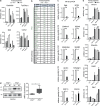PML is a ROS sensor activating p53 upon oxidative stress
- PMID: 28931625
- PMCID: PMC5679165
- DOI: 10.1084/jem.20160301
PML is a ROS sensor activating p53 upon oxidative stress
Abstract
Promyelocytic leukemia (PML) nuclear bodies (NBs) recruit partner proteins, including p53 and its regulators, thereby controlling their abundance or function. Investigating arsenic sensitivity of acute promyelocytic leukemia, we proposed that PML oxidation promotes NB biogenesis. However, physiological links between PML and oxidative stress response in vivo remain unexplored. Here, we identify PML as a reactive oxygen species (ROS) sensor. Pml-/- cells accumulate ROS, whereas PML expression decreases ROS levels. Unexpectedly, Pml-/- embryos survive acute glutathione depletion. Moreover, Pml-/- animals are resistant to acetaminophen hepatotoxicity or fasting-induced steatosis. Molecularly, Pml-/- animals fail to properly activate oxidative stress-responsive p53 targets, whereas the NRF2 response is amplified and accelerated. Finally, in an oxidative stress-prone background, Pml-/- animals display a longevity phenotype, likely reflecting decreased basal p53 activation. Thus, similar to p53, PML exerts basal antioxidant properties but also drives oxidative stress-induced changes in cell survival/proliferation or metabolism in vivo. Through NB biogenesis, PML therefore couples ROS sensing to p53 responses, shedding a new light on the role of PML in senescence or stem cell biology.
© 2017 Niwa-Kawakita et al.
Figures





Similar articles
-
Promyelocytic Leukemia Protein, a Protein at the Crossroad of Oxidative Stress and Metabolism.Antioxid Redox Signal. 2017 Mar 20;26(9):432-444. doi: 10.1089/ars.2016.6898. Epub 2016 Dec 12. Antioxid Redox Signal. 2017. PMID: 27758112 Review.
-
PML/RARA oxidation and arsenic binding initiate the antileukemia response of As2O3.Cancer Cell. 2010 Jul 13;18(1):88-98. doi: 10.1016/j.ccr.2010.06.003. Cancer Cell. 2010. PMID: 20609355
-
Role of nuclear bodies in apoptosis signalling.Biochim Biophys Acta. 2008 Nov;1783(11):2185-94. doi: 10.1016/j.bbamcr.2008.07.002. Epub 2008 Jul 16. Biochim Biophys Acta. 2008. PMID: 18680765 Review.
-
PML nuclear bodies, membrane-less domains acting as ROS sensors?Semin Cell Dev Biol. 2018 Aug;80:29-34. doi: 10.1016/j.semcdb.2017.11.007. Epub 2017 Nov 20. Semin Cell Dev Biol. 2018. PMID: 29157919 Review.
-
PML nuclear bodies: regulation, function and therapeutic perspectives.J Pathol. 2014 Nov;234(3):289-91. doi: 10.1002/path.4426. J Pathol. 2014. PMID: 25138686 Review.
Cited by
-
Ankrd2 in Mechanotransduction and Oxidative Stress Response in Skeletal Muscle: New Cues for the Pathogenesis of Muscular Laminopathies.Oxid Med Cell Longev. 2019 Jul 24;2019:7318796. doi: 10.1155/2019/7318796. eCollection 2019. Oxid Med Cell Longev. 2019. PMID: 31428229 Free PMC article. Review.
-
PML Nuclear Bodies and Cellular Senescence: A Comparative Study of Healthy and Premature Aging Syndrome Donors' Cells.Cells. 2024 Dec 16;13(24):2075. doi: 10.3390/cells13242075. Cells. 2024. PMID: 39768166 Free PMC article.
-
The Multiple Facets of ATRX Protein.Cancers (Basel). 2021 May 5;13(9):2211. doi: 10.3390/cancers13092211. Cancers (Basel). 2021. PMID: 34062956 Free PMC article. Review.
-
Crosstalk between PML and p53 in response to TGF-β1: A new mechanism of cardiac fibroblast activation.Int J Biol Sci. 2023 Jan 22;19(3):994-1006. doi: 10.7150/ijbs.76214. eCollection 2023. Int J Biol Sci. 2023. PMID: 36778116 Free PMC article.
-
PML-Nuclear Bodies Regulate the Stability of the Fusion Protein Dendra2-Nrf2 in the Nucleus.Cell Physiol Biochem. 2018;47(2):800-816. doi: 10.1159/000490033. Epub 2018 May 22. Cell Physiol Biochem. 2018. PMID: 29807365 Free PMC article.
References
MeSH terms
Substances
LinkOut - more resources
Full Text Sources
Other Literature Sources
Molecular Biology Databases
Research Materials
Miscellaneous

